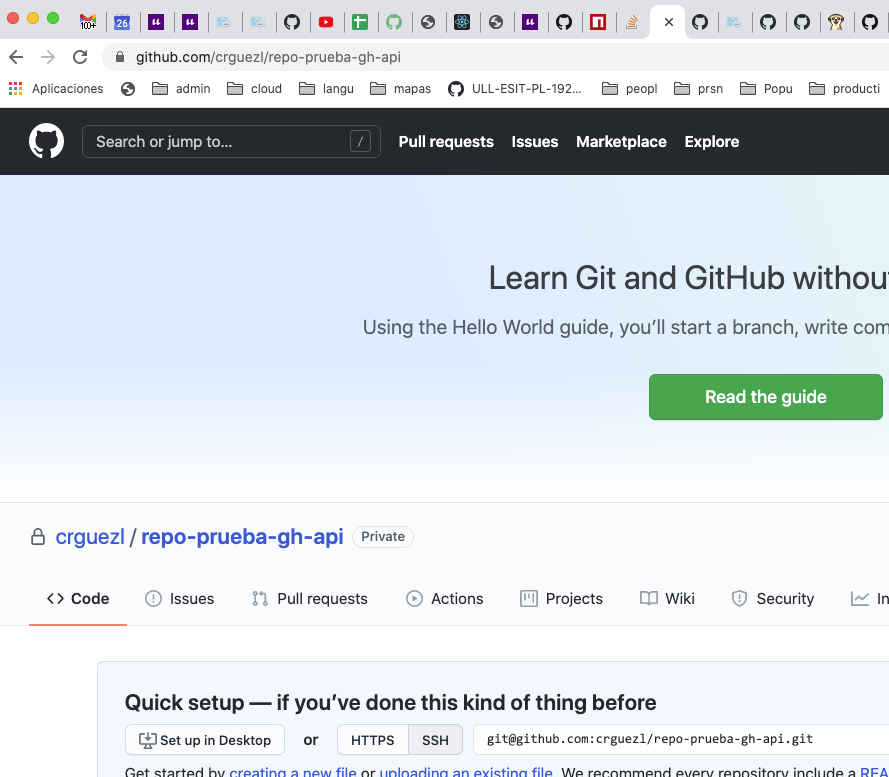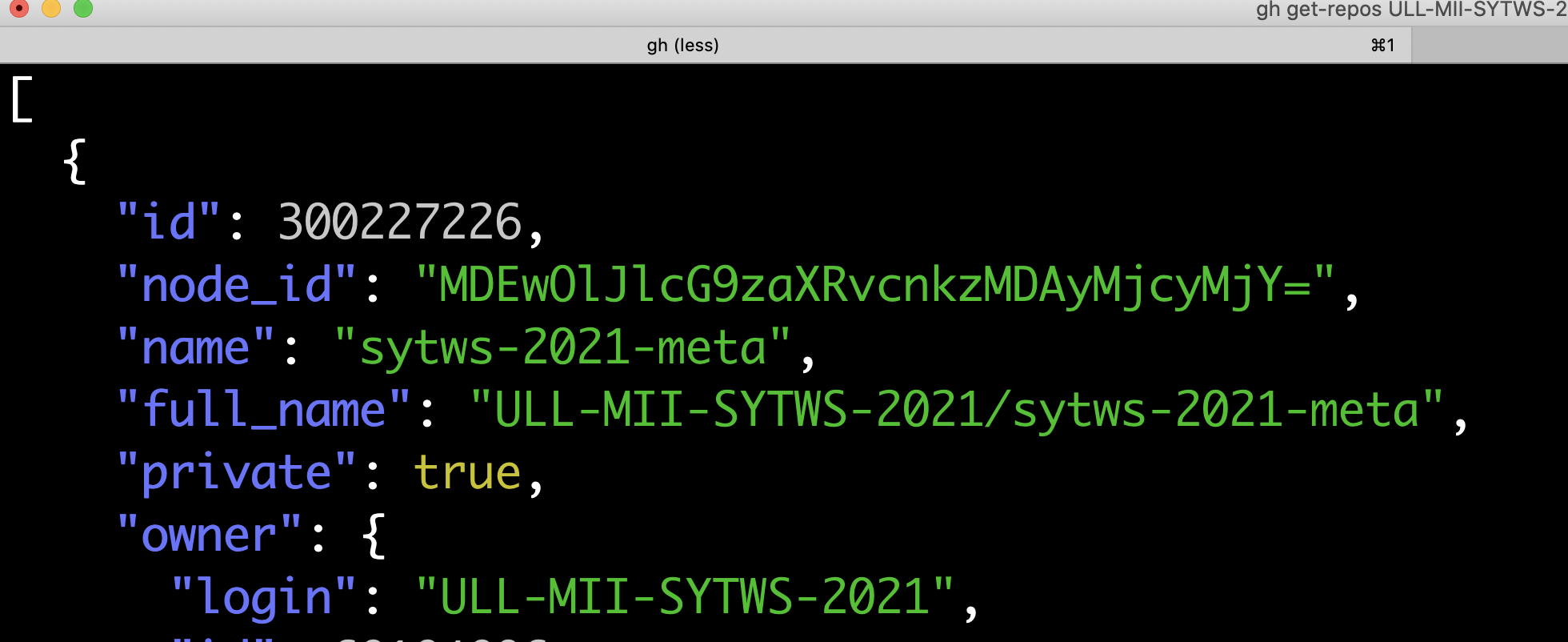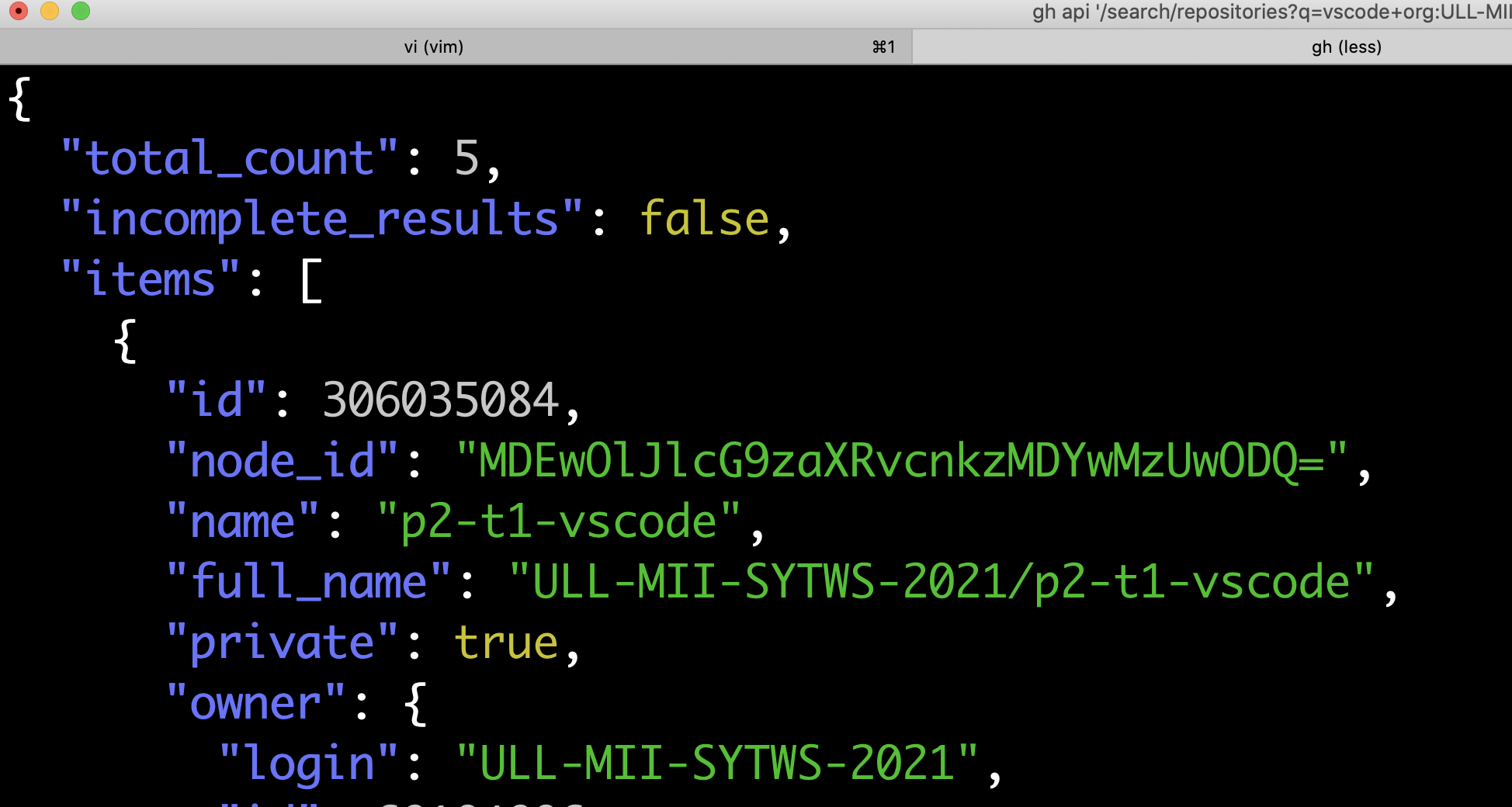Sistemas y Tecnologías Web: Servidor
Master de II. ULL. 1er cuatrimestre. 2020/2021
Organization ULL-MII-SYTWS-2021 Classroom ULL-MII-SYTWS-2021 Campus Virtual SYTWS Chat Chat Profesor Casiano
Table of Contents
GitHub Command Line Interface
gh api
Authentication Token
Go to github.com/settings/tokens
to generate a new token for gh and set then environment variable
GITHUB_TOKEN (export GITHUB_TOKEN= ...)
Example
Placeholder values :owner, :repo, and :branch in the endpoint argument will get replaced with values from the repository of the current directory.
1
2
3
4
5
6
7
8
9
10
11
12
13
14
15
16
17
18
19
[~/.../sytws2021/apuntes(master)]$ gh api repos/:owner/:repo/issues
[
{
"url": "https://api.github.com/repos/ULL-MII-SYTWS-1920/ull-mii-sytws-1920.github.io/issues/5",
"repository_url": "https://api.github.com/repos/ULL-MII-SYTWS-1920/ull-mii-sytws-1920.github.io",
"labels_url": "https://api.github.com/repos/ULL-MII-SYTWS-1920/ull-mii-sytws-1920.github.io/issues/5/labels{/name}",
"comments_url": "https://api.github.com/repos/ULL-MII-SYTWS-1920/ull-mii-sytws-1920.github.io/issues/5/comments",
"events_url": "https://api.github.com/repos/ULL-MII-SYTWS-1920/ull-mii-sytws-1920.github.io/issues/5/events",
"html_url": "https://github.com/ULL-MII-SYTWS-1920/ull-mii-sytws-1920.github.io/issues/5",
"id": 715027457,
"node_id": "MDU6SXNzdWU3MTUwMjc0NTc=",
"number": 5,
"title": "tema0-presentacion/practicas/pb-gh-campus-expert/",
"user": {
...
}
...
}
]
We can pipe the output to jq:
1
2
[~/.../sytws2021/apuntes(master)]$ gh api repos/:owner/:repo/issues | jq '.[0] | .title'
"tema0-presentacion/practicas/pb-gh-campus-expert/"
Of course, we can explicit the repo and owner. For example:
1
2
3
➜ learning git:(master) gh api repos/ULL-MII-SYTWS-2021/p01-t1-iaas-alu0101040882/issues | jq '.[0] | .user.login, .body'
"crguezl"
"Hola @alu0101040882, \r\n\r\nVeo que alguno ya está trabajando en la práctica de
Let us see an example using the POST method. We will start from this curl example
in the GitHub API getting started guide:
1
2
3
4
5
6
7
8
$ curl -i -H "Authorization: token 5199831f4dd3b79e7c5b7e0ebe75d67aa66e79d4" \
-d '{ \
"name": "blog", \
"auto_init": true, \
"private": true, \
"gitignore_template": "nanoc" \
}' \
https://api.github.com/user/repos
and let us adapt to gh api. We use -X or --method stringto set the HTTP method for the request (default GET) and -fto set the fields:
1
➜ /tmp gh api -X POST -f name=repo-prueba-gh-api -f private=true /user/repos
This way we have created a private repo inside the user scope:

Pagination
The option --paginateallow us to make additional HTTP requests to fetch
all pages of results. Here is an example.
1
2
3
4
5
6
➜ to-meta git:(master) ✗ gh alias set get-repos 'api /orgs/$1/repos'
- Adding alias for get-repos: api /orgs/$1/repos
✓ Added alias.
➜ to-meta git:(master) ✗ gh alias list
co: pr checkout
get-repos: api /orgs/$1/repos
1
➜ to-meta git:(master) ✗ gh get-repos ULL-MII-SYTWS-2021

Now we can pipe the output to jq to get the names of the repos:
1
2
3
4
5
6
7
8
➜ to-meta git:(master) ✗ gh get-repos ULL-MII-SYTWS-2021 | jq '.[].full_name' -
"ULL-MII-SYTWS-2021/sytws-2021-meta"
"ULL-MII-SYTWS-2021/sytws2021-private"
"ULL-MII-SYTWS-2021/books-shared"
"ULL-MII-SYTWS-2021/p01-t1-iaas-fcohdezc"
"ULL-MII-SYTWS-2021/p01-t1-iaas-crguezl"
"ULL-MII-SYTWS-2021/p01-t1-iaas-alu0100886870"
...
Let ask for the repos in the PL organization for the course 19/20:
1
2
➜ to-meta git:(master) ✗ gh api /orgs/ULL-ESIT-PL-1920/repos | jq '.[] | .name' | wc
30 30 1088
It gave us 30 repos. There are much more than that in that organization.
If we use --paginate the request takes a long time and gives us near a thousand repos:
1
2
➜ to-meta git:(master) ✗ gh api --paginate /orgs/ULL-ESIT-PL-1920/repos | jq '.[] | .name' | wc
990 990 32868
gh alias
gh alias set
1
➜ to-meta git:(master) ✗ gh help alias set
Declare a word as a command alias that will expand to the specified command(s).
The expansion may specify additional arguments and flags. If the expansion
includes positional placeholders such as $1, $2, etc., any extra arguments
that follow the invocation of an alias will be inserted appropriately.
If --shell is specified, the alias will be run through a shell interpreter (sh). This allows you
to compose commands with | or redirect with >. Note that extra arguments following the alias
will not be automatically passed to the expanded expression. To have a shell alias receive
arguments, you must explicitly accept them using $1, $2, etc., or $@ to accept all of them.
Platform note: on Windows, shell aliases are executed via sh as installed by Git For Windows. If
you have installed git on Windows in some other way, shell aliases may not work for you.
Quotes must always be used when defining a command as in the examples.
USAGE
gh alias set
FLAGS
-s, –shell Declare an alias to be passed through a shell interpreter
INHERITED FLAGS
–help Show help for command
EXAMPLES
1
2
3
4
5
6
7
8
9
10
11
12
13
$ gh alias set pv 'pr view'
$ gh pv -w 123
#=> gh pr view -w 123
$ gh alias set bugs 'issue list --label="bugs"'
$ gh alias set epicsBy 'issue list --author="$1" --label="epic"'
$ gh epicsBy vilmibm
#=> gh issue list --author="vilmibm" --label="epic"
$ gh alias set --shell igrep 'gh issue list --label="$1" | grep $2'
$ gh igrep epic foo
#=> gh issue list --label="epic" | grep "foo"
Let us search for repos inside our organization using GitHub API v3:
1
➜ to-meta git:(master) ✗ gh api '/search/repositories?q=vscode+org:ULL-MII-SYTWS-2021+in:name'

In this link you’ll find the full output.
- See the SEARCH section of the REST API GitHub docs to know more about the API.
- See section Search Repositories for more info on how to search for repos
Now we can use gh alias set to make an alias get-lab to get the repos:
1
2
3
4
5
6
➜ to-meta git:(master) ✗ gh alias set get-labs 'api /search/repositories?q=$2+org:$1+in:name'
- Adding alias for get-labs: api /search/repositories?q=$2+org:$1+in:name
✓ Added alias.
➜ to-meta git:(master) ✗ gh alias list
co: pr checkout
get-labs: api /search/repositories?q=$2+org:$1+in:name
And now we can use it:
1
➜ to-meta git:(master) ✗ gh get-labs ULL-MII-SYTWS-2021 iaas
Next we can pipe the output to jq to get the names of the repos and the date of the last push:
1
2
3
4
5
6
7
8
9
10
11
12
13
➜ to-meta git:(master) ✗ gh get-labs ULL-MII-SYTWS-2021 iaas | jq '.items[] | .name, .pushed_at'
"p01-t1-iaas-juanchojbarroso"
"2020-10-21T15:58:32Z"
"p01-t1-iaas-alu0101040882"
"2020-10-17T16:53:39Z"
"p01-t1-iaas-fcohdezc"
"2020-10-06T17:51:52Z"
"p01-t1-iaas-crguezl"
"2020-10-19T13:50:13Z"
"p01-t1-iaas-alu0100886870"
"2020-10-21T17:05:08Z"
"p01-t1-iaas-lardabi"
"2020-10-06T18:01:16Z"
We can improve it by writing a script:
1
➜ to-meta git:(master) ✗ cat ~/bin/repos
1
2
3
4
5
6
7
8
9
10
11
12
13
14
#!/bin/bash
ORG=ULL-MII-SYTWS-2021
ASSIGNMENT=iaas
if [[ $# -gt 0 ]] ; then
ASSIGNMENT=$1
fi
if [[ $# -gt 1 ]] ; then
ORG=$2
fi
# echo $ASSIGNMENT $ORG
gh api --paginate /search/repositories?q=$ASSIGNMENT+org:$ORG+in:name |
jq '.items[] | .name, .pushed_at' |
sed 'N;s/\n/ => /'
Let us make an alias for gh:
1
2
3
➜ to-meta git:(master) ✗ gh alias set --shell get-repos 'repos $1 $2'
- Adding alias for get-repos: repos $1 $2
✓ Changed alias get-repos from !repos to !repos $1 $2
Watch the use of single quotes.
Let us use our new alias:
1
2
3
4
5
6
7
8
9
➜ apuntes git:(curso2021) gh get-repos TFA ULL-ESIT-PL-1920
"tfa-module-miguel-tfa" => "2020-09-04T09:40:57Z"
"tfa-daniel-tfa" => "2020-06-02T14:00:30Z"
"tfa-manuel-jorge-tfa" => "2020-09-13T21:40:24Z"
"tfa-basilio-tfa" => "2020-07-14T06:49:29Z"
"tfa-alien-tfa" => "2020-09-05T07:35:52Z"
"tfa-miguel-angel-tfa" => "2020-09-15T13:19:47Z"
"tfa-esther-sergio-tfa" => "2020-07-10T08:53:04Z"
...
LEARN MORE
Use gh <command> <subcommand> --help for more information about a command.
Read the manual at https://cli.github.com/manual
GraphQL Example
GraphQL is a query language for web services APIs and a runtime for fulfilling those queries with your existing data. GraphQL provides a complete and understandable description of the data in your API, gives clients the power to ask for exactly what they need and nothing more.
Follows an example of query using GraphQL.
We can set the GraphQL query in a separated file:
1
➜ bin git:(master) cat gh-api-example.graphql
1
2
3
4
5
6
7
8
9
10
11
12
13
14
15
16
17
18
19
query {
repository(owner:"ULL-MII-SYTWS-2021", name:"p01-t1-iaas-alu0101040882") {
issues(last:2, states:OPEN) {
edges {
node {
title
url
labels(first:5) {
edges {
node {
name
}
}
}
}
}
}
}
}
To learn more, see the tutorial Forming calls with GraphQL .
Looking at the composition line by line:
1
query {
Because we want to read data from the server, not modify it, query is the root operation. (If you don’t specify an operation, query is also the default.)
1
repository(owner:"ULL-MII-SYTWS-2021", name:"p01-t1-iaas-alu0101040882")
To begin the query, we want to find a repository object. The schema validation indicates this object requires an owner and a name argument. A schema defines a GraphQL API’s type system. It describes the complete set of possible data (objects, fields, relationships, everything) that a client can access
1
issues(last:2, states:OPEN) {
A field is a unit of data you can retrieve from an object. As the official GraphQL docs say: The GraphQL query language is basically about selecting fields on objects.
To account for all issues in the repository, we call the issues object.
Some details about the issues object:
The docs tell us this object has the type IssueConnection.
Schema validation indicates this object requires a last or first number of results as an argument, so we provide 2.
The docs also tell us this object accepts a states argument, which is an IssueState enum that accepts OPEN or CLOSED values.
To find only open issues, we give the states key a value of OPEN.
1
edges {
Edges represent connections between nodes. When you query a connection, you traverse its edges to get to its nodes.
We know issues is a *connection** because the Doc says it has the IssueConnection type.
Connections let us query related objects as part of the same call. With connections, we can use a single GraphQL call where we would have to use multiple calls to a REST API.
To retrieve data about individual issues, we have to access the node via edges.
1
node {
Here we retrieve the node at the end of the edge.
The IssueConnection docs indicate the node at the end of the IssueConnection type is an Issue object.
Now that we know we’re retrieving an Issue object, we can look at the docs for issue and specify the fields we want to return:
1
2
3
4
5
6
7
8
9
title
url
labels(first:5) {
edges {
node {
name
}
}
}
Here we specify the title, url, and labels fields of the Issue object.
The labels field has the type LabelConnection. As with the issues object, because labels is a connection, we must travel its edges to a connected node: the label object. At the node, we can specify the label object fields we want to return, in this case, name.
In gh, the --field flag behaves like --raw-field with magic type conversion based on the format of the value:
- literal values “true”, “false”, “null”, and integer numbers get converted to appropriate JSON types;
- placeholder values “:owner”, “:repo”, and “:branch” get populated with values from the repository of the current directory;
- if the value starts with “@”, the rest of the value is interpreted as a filename to read the value from. Pass “-“ to read from standard input.
For GraphQL requests, all fields other than “query” and “operationName” are interpreted as GraphQL variables.
1
2
3
4
5
6
7
8
9
10
11
12
13
14
15
16
17
18
19
20
21
22
23
24
25
26
➜ bin git:(master) gh api graphql --paginate -F query=@gh-api-example.graphql | jq .
{
"data": {
"repository": {
"issues": {
"edges": [
{
"node": {
"title": "Revisión",
"url": "https://github.com/ULL-MII-SYTWS-2021/p01-t1-iaas-alu0101040882/issues/2",
"labels": {
"edges": [
{
"node": {
"name": "enhancement"
}
}
]
}
}
}
]
}
}
}
}
Descripción de la práctica p6-t1-gh-cli
Descripción de la práctica p6-t1-gh-cli